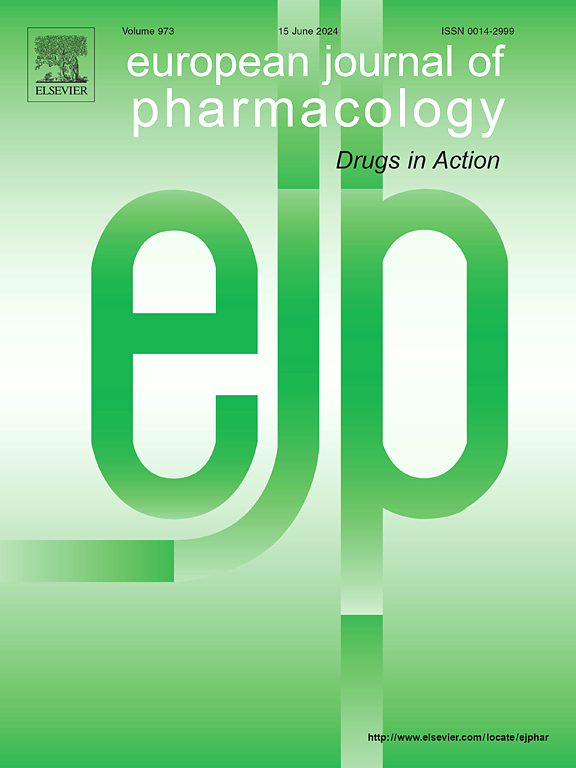丹那antha通过上调NAG-1、下调CRM1和诱导自噬在乳腺癌细胞中发挥抗癌作用。
IF 4.2
3区 医学
Q1 PHARMACOLOGY & PHARMACY
引用次数: 0
摘要
乳腺癌仍然是全世界癌症相关死亡的一个主要原因,强调迫切需要创新的治疗方法。本研究探讨了丹那anthal在乳腺癌细胞系BT-20和MCF-7中的抗癌潜力,重点研究了其对关键生物标志物NAG-1(非甾体抗炎药激活基因-1)和CRM1(染色体区域维持1)的调控作用。NAG-1被认为具有促凋亡和抗肿瘤作用,而CRM1则与致癌活性相关。我们发现大那他钠治疗显著增加了NAG-1的表达,并以剂量和时间依赖性的方式降低了CRM1的表达。功能分析表明,大那anthal抑制细胞增殖,减少集落形成,并减少肿瘤球体大小。从机制上讲,荧光素酶报告基因分析显示,damnacanthal通过C/EBP-β激活了NAG-1启动子的-133至+41区域。Real-time PCR和Western blotting分析证实,NAG-1在转录上上调,而CRM1在翻译后通过增强蛋白质降解而下调,这一点得到了环己亚胺追踪试验的证实。分子对接提示damnacanthal与CRM1直接结合,这可能解释了其稳定性降低的原因。此外,大纳anthal通过上调NAG-1诱导自噬,LC3-II表达增加,自噬通量增加,免疫细胞化学进一步证实了这一点。这些研究结果表明,大那坎塔尔通过调节NAG-1和CRM1的表达,抑制肿瘤细胞生长,诱导自噬,具有有效的抗癌作用。这突出了其作为一种新型乳腺癌治疗药物的治疗潜力,值得进一步的临床探索。本文章由计算机程序翻译,如有差异,请以英文原文为准。
Damnacanthal exerts anti-cancer effects in breast cancer cells via NAG-1 upregulation, CRM1 downregulation, and induction of autophagy
Breast cancer continues to be a major cause of cancer-related deaths worldwide, emphasizing the urgent need for innovative treatments. This study investigates the anti-cancer potential of damnacanthal in breast cancer cell lines BT-20 and MCF-7, highlighting its regulatory effects on key biomarkers NAG-1 (Nonsteroidal Anti-inflammatory Drug-Activated Gene-1) and CRM1 (Chromosome Region Maintenance 1). NAG-1 is recognized for its pro-apoptotic and anti-tumorigenic roles, while CRM1 is associated with oncogenic activity. We found that damnacanthal treatment significantly increased NAG-1 expression and decreased CRM1 expression in a dose- and time-dependent manner. Functional assays demonstrated that damnacanthal inhibited cell proliferation, reduced colony formation, and decreased tumor spheroid size. Mechanistically, luciferase reporter assays revealed that damnacanthal activates the −133 to +41 region of the NAG-1 promoter through C/EBP-β. Real-time PCR and Western blotting analyses confirmed that NAG-1 is upregulated transcriptionally, whereas CRM1 is downregulated post-translationally via enhanced protein degradation, as evidenced by cycloheximide chase assays. Molecular docking suggested direct binding of damnacanthal to CRM1, potentially explaining its reduced stability. Additionally, damnacanthal induced autophagy by upregulating NAG-1, as indicated by increased LC3-II expression and autophagic flux, further confirmed by immunocytochemistry. These findings suggest that damnacanthal exerts potent anti-cancer effects by modulating NAG-1 and CRM1 expressions, inhibiting tumor cell growth, and inducing autophagy. This highlights its therapeutic potential as a novel agent for breast cancer treatment, warranting further clinical exploration.
求助全文
通过发布文献求助,成功后即可免费获取论文全文。
去求助
来源期刊
CiteScore
9.00
自引率
0.00%
发文量
572
审稿时长
34 days
期刊介绍:
The European Journal of Pharmacology publishes research papers covering all aspects of experimental pharmacology with focus on the mechanism of action of structurally identified compounds affecting biological systems.
The scope includes:
Behavioural pharmacology
Neuropharmacology and analgesia
Cardiovascular pharmacology
Pulmonary, gastrointestinal and urogenital pharmacology
Endocrine pharmacology
Immunopharmacology and inflammation
Molecular and cellular pharmacology
Regenerative pharmacology
Biologicals and biotherapeutics
Translational pharmacology
Nutriceutical pharmacology.

 求助内容:
求助内容: 应助结果提醒方式:
应助结果提醒方式:


